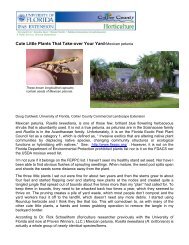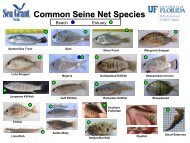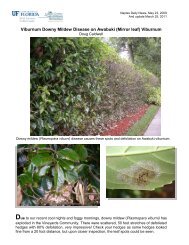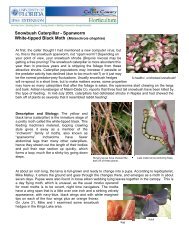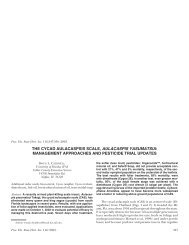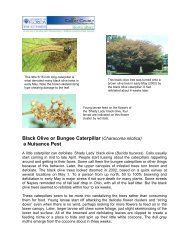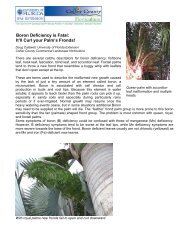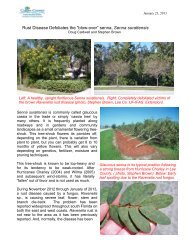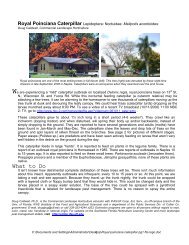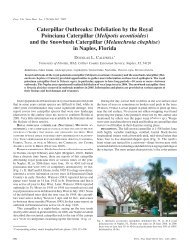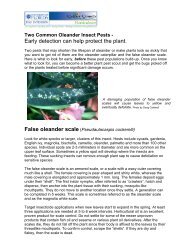bugs shrubs buzz - Collier County Extension Office - University of ...
bugs shrubs buzz - Collier County Extension Office - University of ...
bugs shrubs buzz - Collier County Extension Office - University of ...
Create successful ePaper yourself
Turn your PDF publications into a flip-book with our unique Google optimized e-Paper software.
EDITION TWO • MAY 2012<br />
Downy Mildew Blight Defoliates Awabuki Viburnum<br />
During our cool January and February nights and foggy<br />
mornings, downy mildew (Plasmopara viburni) disease<br />
established a foothold in many communities.<br />
This is the second year in a row <strong>of</strong> severe defoliation.<br />
There are scattered, 50 foot stretches <strong>of</strong> defoliated<br />
Awabuki viburnum hedges with 80% defoliation in<br />
many communities. Check your hedges; we found<br />
some hedges looked fine from a 20 foot distance, but<br />
upon closer inspection, the leaf blight was evident.<br />
Strangely, the defoliation appears to be worse in<br />
sunny sections as opposed to shady sections.<br />
Awabuki (commonly referred to as mirror-leaf viburnum)<br />
is a variety <strong>of</strong> sweet viburnum, Viburnum<br />
odoratissimum var. Awabuki. This South Korean<br />
native has been around since 1987 or so and can be<br />
recognized by the big, dark green shiny leaves as well<br />
as the green pepper fragrance <strong>of</strong> crushed leaves<br />
What to Look For<br />
During cool, humid winter nights the downy mildew<br />
pathogen moves in on weak plants and causes spotting<br />
and bronzy blotching (light green to reddishbrown<br />
to black), yellowing, distorted leaves and defoliation.<br />
A whitish growth eventually develops on the<br />
undersides <strong>of</strong> the leaves and produces spores which<br />
spread the disease. This is a minor disease usually, but<br />
it has caused extensive defoliation when the weather<br />
is cool and humid. Once the hotter days <strong>of</strong> late spring<br />
arrive, the disease tends to dissipate.<br />
What to Do<br />
Two key points in control are removal <strong>of</strong> fallen<br />
infected leaves: get those out <strong>of</strong> your landscape and<br />
do not compost! Good luck! And secondly, check that<br />
the sprinkler system is not directly hitting the foliage.<br />
The water will disperse the spores and the disease will<br />
consume more <strong>of</strong> your hedge.<br />
6<br />
Symptoms <strong>of</strong> downy mildew blight (Plasmopara<br />
viburni) include irregular shaped spots and<br />
blotches, distorted leaves and defoliation.<br />
Dr. Dougbug’s Newsletter for Commercial Landscape Horticulture<br />
–Doug Caldwell<br />
Downy mildew disease caused this defoliation. Clean-up<br />
<strong>of</strong> fallen leaves will help reduce future disease severity.




